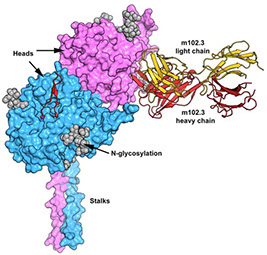The Problem
A variety of species of bats are the known natural reservoir hosts for a variety of pathogens, such as Ebola virus and Marburg virus, Rabies-like viruses, SARs like coronaviruses and Nipah and Hendra viruses that can cause severe and often fatal disease in humans. There have been recurrent outbreaks of Nipah and Hendra (the henipaviruses) and also Ebola virus ever since their discovery and isolation and there are currently no FDA licensed vaccines or therapeutics available for human use, making them biodefense concerns to both the civilian and military populations. The highest level of containment (BSL-4) is required to work with these viruses which which can create challenges when studying viral pathogenesis, host cell interactions, and the host response during infection.
Inside the Lab
Structural and Functional Analyses
Our laboratory has been pursuing structural and functional analyses on the interactions between host cells and enveloped viruses such as Hendra, Nipah Cedar, and Mojiang viruses, and Australian bat lyssavirus and filoviruses (Ebola and Marburg) using immunological, biochemical, and genetic approaches. The goals of our work are to identify the steps and requirements of viral envelope glycoprotein (Env)-mediated membrane fusion, the determinants of viral tropism, and the discovery of new viral receptors. We develop and characterize soluble, native-like, oligomeric viral glycoproteins and examine their immunological characteristics including the potential to induce neutralizing antibody responses in vivo. These recombinant viral glycoproteins are also being used in several biosurveillance studies for the detection of antiviral antibodies in wildlife, livestock, and humans. A variety of tools are used in the laboratory including animal cell expression and purification of viral membrane glycoproteins, cell-cell reporter gene fusion assays, monoclonal antibody development, and viral reverse genetic systems.
Rescued Cedar virus using molecular cloning and reverse genetics
We have successfully rescued Cedar virus using molecular cloning and reverse genetics. Cedar virus is a non-pathogenic virus genetically related to Hendra virus and Nipah virus. We expanded our platform to include, in addition to the recombinant wild type Cedar virus, 2 recombinant reporter viruses either expressing a green fluorescent protein or a luciferase protein. Our recombinant Cedar virus forms the hallmark giant nucleatedcells (syncytia) in infected cells (figure shown below, yellow boxes indicate syncytia), recognizes the characterized ephrin B2 as the entry receptor and induces an interferon response in human cells.
Various aspects of henipavirus cell biology can now be studied using our recombinant Cedar virus platform, such as characterizing the determinants of henipavirus pathogenesis, identifying important host viral interactions, investigating receptor tropisms, and it can be adapted for use in high-throughput assays for the discovery and identification of novel pan-henipavirus antivirals safely under BSL-2 conditions.
Biosurveillance for emerging zoonotic RNA viruses
Henipaviruses (e.g. Nipah virus) and filoviruses (e.g. Ebola virus and Marburg virus) are World Health Organization (WHO) priority pathogens and classified by the U.S. Department of Health and Human Services (HHS) and the Centers for Disease Control (CDC) as select agents. Infection with Nipah virus and the related Hendra virus can cause fatal respiratory and encephalitic disease; whereas Ebola virus and Marburg virus infection leads to a viral hemorrhagic fever. Nipah virus and Hendra virus first emerged in Malaysia and Australia, respectively, and Nipah virus is endemic in Bangladesh where it causes annual outbreaks of henipaviral disease. In 2018, and outbreak of Nipah virus disease was reported in Kerala, India nearly 2000 km from West Bengal and Bangladesh. Prior to an outbreak of Ebola virus from 2014-2016 in West Africa which caused 11,310 fatalities with 28,616 laboratory-confirmed human infections, Ebola virus disease had only been observed in Central African countries: Gabon, Democratic Republic of Congo, and Republic of Congo. The outbreaks of Ebola virus disease and Nipah virus disease in previous non-endemic countries highlighted the necessity for comprehensive global surveillance of these pathogens.
Henipaviruses and filoviruses are naturally maintained in wildlife with bat species regarded as the primary host reservoirs. Direct virus transmission from bats and virus transmission involving intermediate domestic animals and wildlife have both been implicated in henipavirus and filovirus spill-overs. To improve risk assessment of Nipah virus and Ebola virus emergence, we are engaged in collaborative surveillance projects investigating the geographical footprint of henipaviruses and filoviruses. Through DoD DTRA CBEP-funded programs we are working with academic and government institutions in Malaysia, India, Singapore, Thailand, and South Africa to improve virus surveillance networks through technology transfers and capacity training. Through the identification of high risk interfaces for viral disease spillover we aim to improve early warning detection of these viral diseases and promote global health security as well as health protection of Joint Forces deployed in these regions.
Vaccines
We are also interested in both vaccine and monoclonal antibody therapeutics development. Hendra and Nipah virus are particularly interesting because of their broad species tropism and highly pathogenic nature, and each virus has continued to re-emerge, causing human and animal deaths. Potential antiviral therapeutics and vaccines have been developed against Hendra and Nipah virus.
Hendra G glycoprotein subunit vaccine (HeV-sG)
Our Hendra G glycoprotein subunit vaccine (HeV-sG) is marketed in Australia, manufactured by Zoetis, Inc., (Equivac® HeV) to prevent Hendra virus infection of horses and break the transmission of Hendra infection to people and has been a successful One-Health strategy to counter the transboundary threat posed by Hendra virus infection to both animal and human health.
Developing HeV-sG as a human vaccine for Hendra and Nipah
We are currently developing HeV-sG as human vaccine for Hendra and Nipah viruses in collaboration with Profectus Biosciences Inc., and its development is now supported by CEPI. A Phase I clinical trial of the anti-Nipah/Hendra human monoclonal antibody (m102.4) was completed in 2016. m102.4 has proven successful in nonhuman primates to provide complete post-exposure protection against both Nipah and Hendra virus infection and disease, and has been administered to people on an emergency use basis in Australia and the US.







